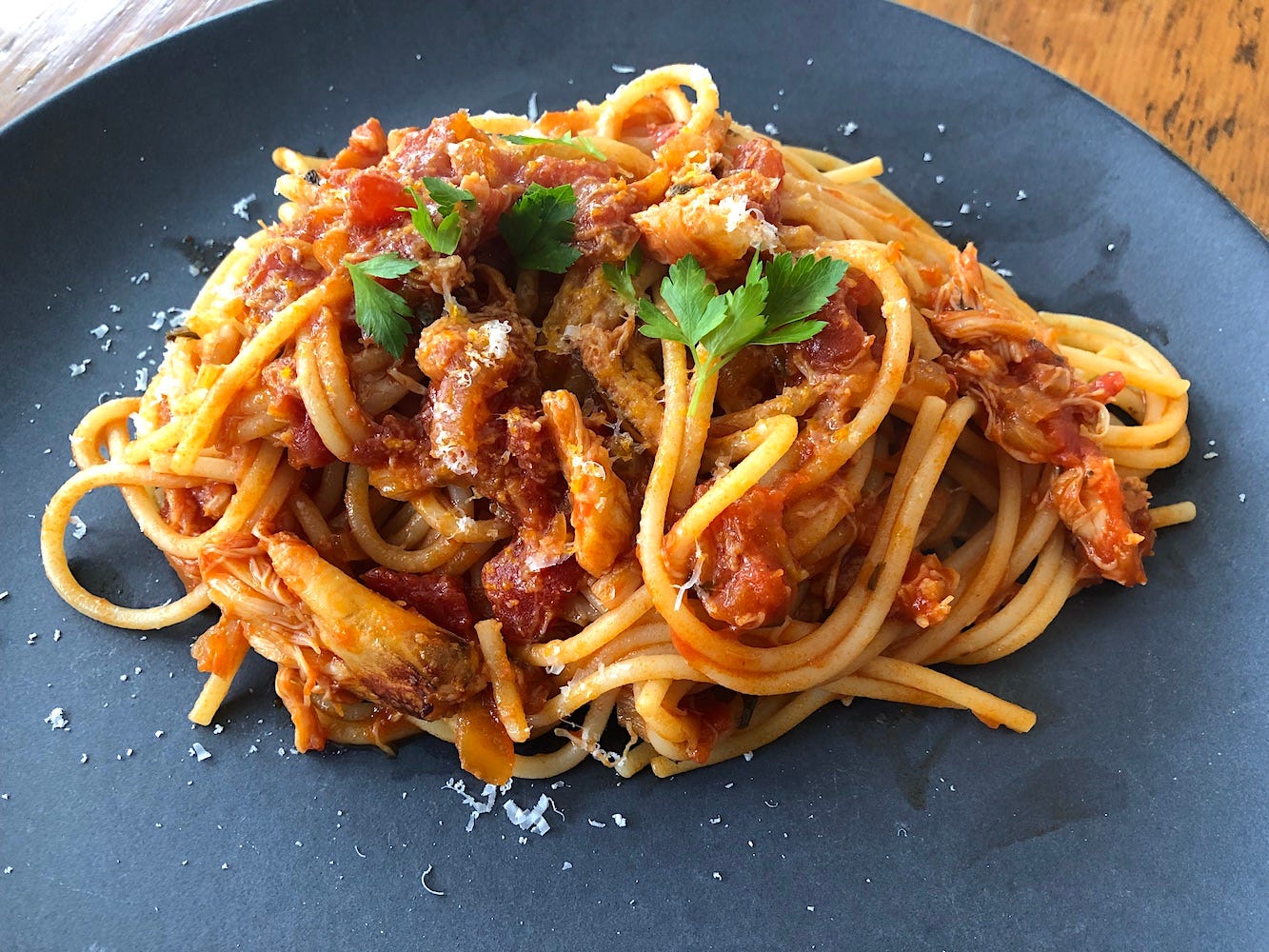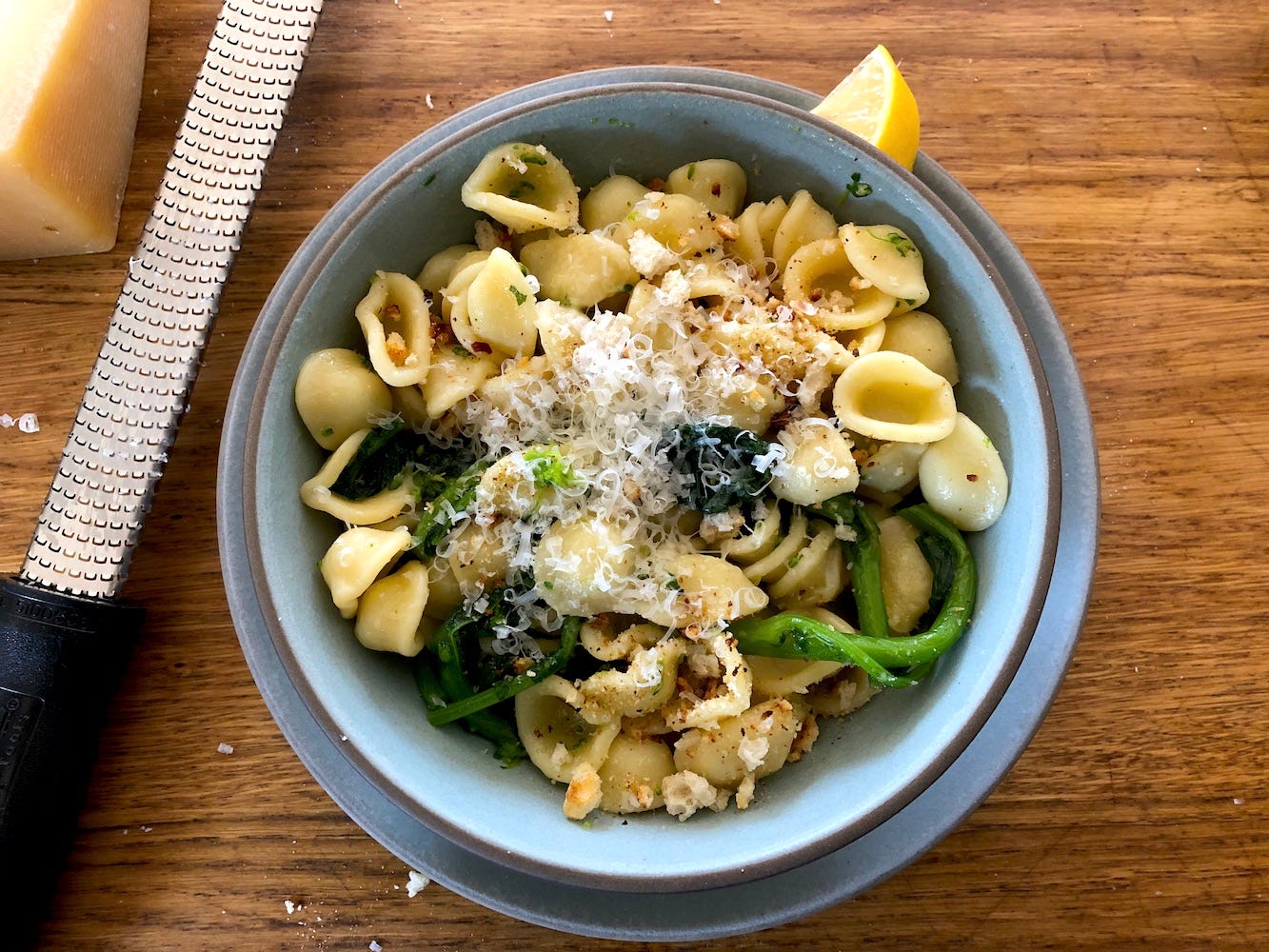Spaghetti with Crab Sauce
A delicious (and decadent) dish from the 1976 California Heritage Cookbook
Hello, lovely readers and cooks! This week I have a treat of a recipe for you, and it comes from an unlikely source: a community cookbook published 47 years ago by the Junior League of Pasedena. The California Heritage Cookbook is a stunning and sometimes perplexing book. It’s enormous—424 pages, with more than 540 recipes—and it has recipes ranging from molded salads to chow mein to asparagus with orange butter. Given its publication date, you might not think the book would still be relevant today, but as I wrote about for the Stained Page newsletter this week, it actually holds up in really interesting and unique ways. Plus, a lot of the recipes still feel fresh and relevant. This one of them. Enjoy!
Spaghetti with Crab Sauce
This spaghetti, made with a rich tomato sauce and lots of crab meat, feels incredibly decadent. The ratio in the original recipe is one pound of crab meat to one pound of spaghetti—meaning there’s just as much meat on the plate as pasta. Given how expensive crab is, I ended up halving that measurement when I made the dish, and the result was still phenomenal. (It was so good, in fact, that both my kid and my husband immediately asked if we could have it more often—or at least for special occasions.)
The version of the recipe below is not exactly the same as the one printed in the California Heritage Cookbook; ingredients like canned tomatoes come in slightly different formats today than they did in the ‘70s, so I had to make some minor adjustments. But I’ve kept the recipe as true to the original as possible, and the flavors are wonderful. I particularly enjoyed making this dish this spring, after Dungeness season was cut short, as a way to enjoy a bit more of this seasonal ingredient even though I no longer had access to the fresh stuff. I hope you enjoy it, too!
Serves 4
3 tablespoons extra virgin olive oil
1 tablespoon minced celery
1 tablespoon minced parsley
1 clove of garlic, minced
1 medium yellow onion, chopped
1 cup diced canned tomato (with its liquid)
⅓ cup tomato paste
1 teaspoon kosher salt
½ teaspoon dried basil
½ teaspoon dried oregano
¼ teaspoon sweet smoked paprika
Freshly ground black pepper
Pinch of granulated sugar
½ lb well-picked crab meat
¼ cup dry sherry
1 lb spaghetti
Freshly grated Parmesan
Parsley, to garnish (optional)
Heat the oil in a very large skillet (or a Dutch open) over medium-low heat, then sauté the celery, parsley, garlic, and onion until lightly browned, about 10 minutes.
Add the tomato, tomato paste, salt, basil, oregano, paprika, pepper, and sugar and about 1 cup of water. Turn the heat to low and simmer the sauce, stirring occasionally, until the liquid has evaporated, about 15 minutes. (If the liquid boils away too quickly, add a bit more water.)
Add the crab meat and sherry, and simmer until the sauce boils, then turn off the heat and cover the pan.
Cook the pasta according to the manufacturer’s instructions until very al dente. Using tongs, transfer the pasta to the pan with the sauce, and toss well. Add a scoop of water from the pasta pot, turn the heat back on under the sauce pan, and cook the pasta and sauce together, stirring and flipping gently with tongs, for a couple of minutes.
Serve the pasta hot with parmesan on top and parsley, if using.
More California Stories
I recently had the great pleasure of interviewing Andres Florez of Snail Bar in Oakland about his creative process. The piece (along with a fun video of his work process) was published this week by the Eames Institute.
I’ve also been thrilled to see so many CA-based writers hop onto Substack in the past few months. My favorite recent pieces include Andrea Nguyen’s musings on where Vietnamese food is going and Michael Procopio’s story about his grandmother foiling a bag snatcher.
From the Archives
If you want another simple (but much more economical) pasta recipe, check out Kate Leahy’s wonderful Pasta and Broccoli Rabe with Garlic, Chile, Parmesan, and Breadcrumbs, which I published back in January 2022. It’s a perfect one-pot dinner.
Photos: Georgia Freedman





